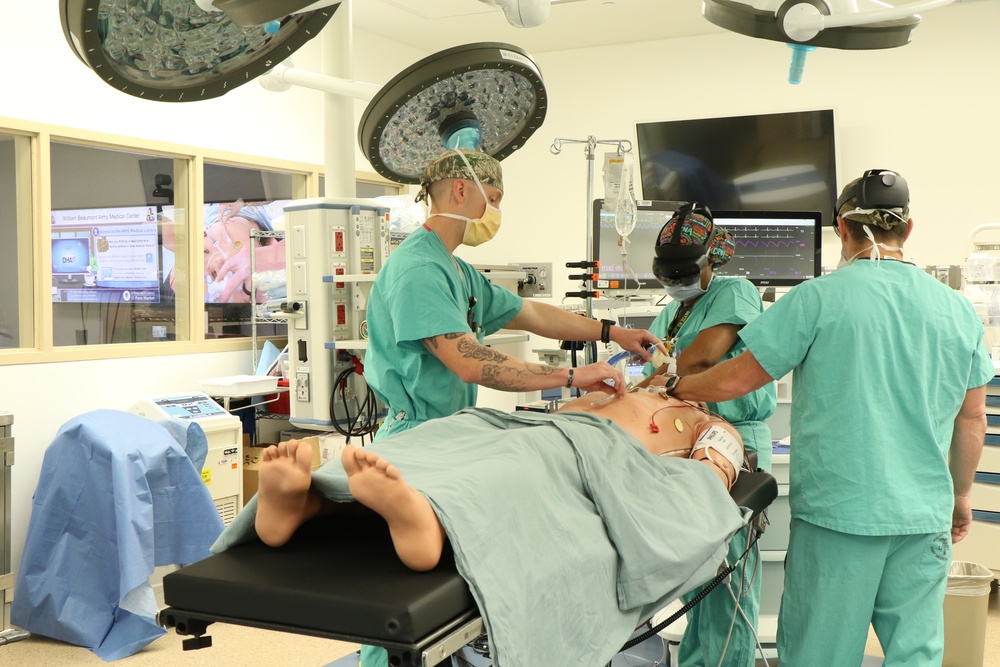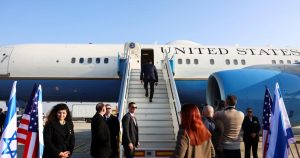FORT BLISS, Texas — Anesthesiologists at William Beaumont Army Medical Center are using advanced simulation technology, including virtual reality tools, to enhance emergency preparedness and sharpen life-saving skills in high-stakes scenarios.
During a training exercise on March 26 in the hospital’s simulation operating room, hospital anesthesiologists and staff confronted a simulated case of malignant hyperthermia (MH), a rare but potentially fatal condition that can occur during anesthesia. If left untreated, MH causes the patient’s body temperature to rise uncontrollably, leading to organ failure or death. The exercise focused on diagnosing the condition quickly, administering the antidote dantrolene, and managing the emergency as a coordinated team.
Leading the anesthesia team during simulation and training was Maj. Tenesha Middleton, a Certified Registered Nurse Anesthetist (CRNA) at WBAMC. Middleton emphasized the importance of resource management and early intervention in the operating room.
“Knowing where your resources are and calling your resources early in the OR is what I will take away from this,” Middleton said. “It’s good simulation, and I think the technology we have is important, especially for people going through training. An MH doesn’t happen often, but it is something we must know how to react to quickly.” She added that the drill left her feeling more prepared in case the situation ever arises in a real operating room.
The hospital incorporated cutting-edge technology to enhance the training experience, including Microsoft HoloLens, a virtual reality headset that recorded the anesthesiology team’s actions from multiple angles. After the simulation, the team reviewed the playback to discuss their performance and identify areas for improvement.
The integration of HoloLens technology also supports WBAMC’s efforts to meet the standards of the Maintenance of Certification in Anesthesiology (MOCA) program, a national initiative that assures patients of the department’s commitment to safety and quality clinical outcomes.
“This training today was a side benefit for our staff,” said Daniel Comerci, WBAMC’s medical director for the MOCA program and a staff anesthesiologist. “Our goal is to run quarterly simulations within the department of anesthesia so we can practice preparing for emergencies in the operating room. With this training, we are preparing ourselves to maintain a very successful anesthesia and MOCA program.”
The hospital’s MOCA review is scheduled for May 2025, and the anesthesiology department is working to enhance emergency response readiness through regular simulation exercises.
By combining hands-on practice, virtual reality tools, and post-simulation debriefs, WBAMC aims to ensure its staff can handle critical emergencies with precision, confidence, and speed—ultimately improving patient safety and clinical outcomes in real-world situations.
WBAMC also leads in medical education, providing training for military healthcare professionals through graduate programs, residency opportunities, and advanced simulation technology. This emphasis on cutting-edge training directly benefits Soldiers’ medical readiness by preparing medical staff to respond effectively to critical emergencies both on the battlefield and in clinical settings.
| Date Taken: | 03.26.2025 |
| Date Posted: | 03.28.2025 13:12 |
| Story ID: | 494010 |
| Location: | FORT BLISS, TEXAS, US |
| Hometown: | EL PASO, TEXAS, US |
| Hometown: | FORT BLISS, TEXAS, US |
| Web Views: | 3 |
| Downloads: | 0 |
PUBLIC DOMAIN

This work, Advanced Simulation Technology at WBAMC help Anesthesiologists Train for Emergencies and MOCA Program Initiatives, by Amabilia Payen, identified by DVIDS, must comply with the restrictions shown on https://www.dvidshub.net/about/copyright.








